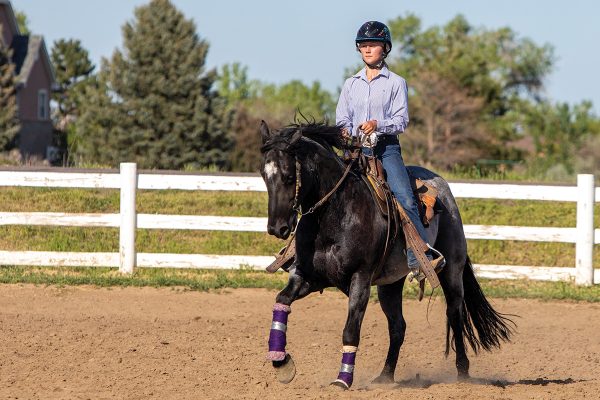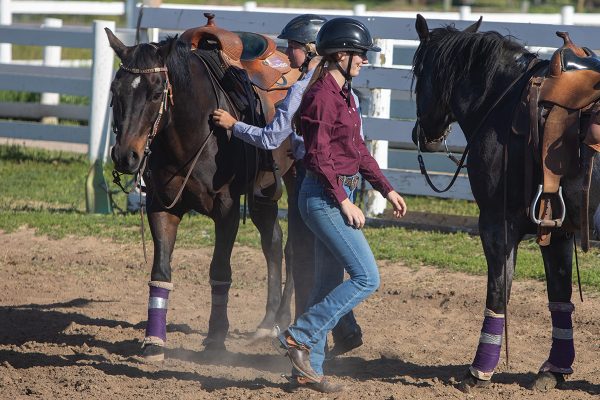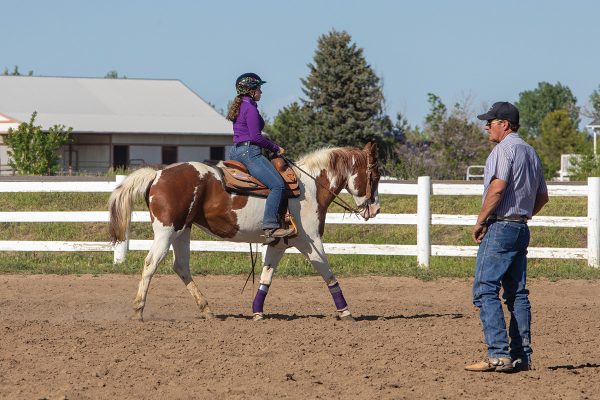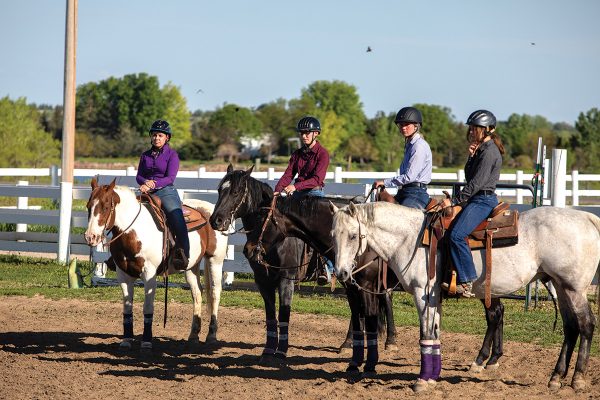As part of any team, practice hopefully means scoring more points in competition. When you ride on an Interscholastic Equestrian Association (IEA) team for grades 4-12, you practice your own horsemanship skills and must work with your team. At the middle school and high school shows, riders draw a horse’s name, then must ride and show the horse with little warm-up time. To succeed in the sport, riders must have great skills, patience, and a team camaraderie.

In these photos, Rocky Mountain Wranglers IEA team members practiced for their 2021 regionals and finals with coach Mark Guynn in Berthoud, Colo. We attended a western team practice to find out how riders prepare to ride horses they don’t know at a team competition.
Switching Horses
“We try to get them on different horses all the time,” says Mark. “The students warm up with one horse and then switch so they can ride a lot of different types of horses. Some horses need to be held onto a little bit, and some can have more rein. The riders learn how the horses were trained in the past and how they need to be ridden to perform well.”

The group ride we attended included riders of all different levels riding very different horses. Several of the horses had been cow horses in the past and required a little more rein hold to slow them to the needed show pace. Others needed a little more push to keep going. One younger horse needed support with constant direction. The bay horse had shown many times, so he made it easy for riders to relax and show off their posture.
Horsemanship
Mark says his team members arrive before practice time so they can catch, groom and tack up their horse for the day. The students learn the full sequence and aren’t handed a horse that’s ready to go.
“If a rider is late, we ask the other team members to help them get ready,” he says. “That brings the team aspect into it. This is as much a team thing as it is individual. They all have to cheer each other on.”
The riders lead their horses to the arena and warm up at the walk and trot on their own. When practice officially starts, Mark directs their work on the rail, then sets up a pattern with cones so they can practice their circles, stops and gait changes. In a show, riders will have time on the rail as well as a required pattern.
The First Ride
At this practice, the riders ride their first horses on the rail, then complete a pattern where they must trot in, pick up a right lead and lope a circle, and then trot a circle to the left, before they end with a stop and back. Mark stands in the middle of the arena to watch each move, then provide his critique once riders finish.
He praises each rider for their strengths, then adds a note of something to work on next time.
If not riding the pattern, the other riders watch intently, learning what worked well with the horse and what they may need to do differently to ride that horse successfully in the future. The riders can’t tune out: part of their practice is to watch and notice what each horse needs in order to successfully maneuver the pattern.
After all the riders complete the pattern once, they dismount and coordinate horse-holding while each switches to a new horse. The riders quickly share their tips about the horse and how he is behaving.
The Next Ride
Once back in a different saddle, the riders complete the pattern again, considering their cues and how much pressure will be needed to help the new horse complete the same pattern.
Mark says that when the lessons have less riders, he tries to make time for them to swap horses enough times so that they can ride all the horses.

At the end of the lesson, Mark calls all the riders to the center of the arena, where they each say something good that they noticed about a teammate’s rides.
“This is my favorite part,” he says. “It’s all student-led, and I love hearing what they say to encourage one another.”
The teammates share their “props” for each other and point out what they noticed that each handled well. They all applaud and agree with the praise given and end their rides on a positive note.
On the way back to the barn to untack, the teammates let down a little more and talk freely about their rides and their days. The laughs and smiles show that this really is a team sport.

This article about Interscholastic Equestrian Association practice appeared in the Winter 2022 issue of Young Rider magazine. Click here to subscribe!


